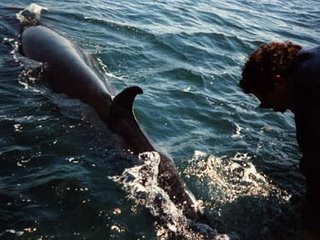
On Tuesday, June 29, 1995 35 passengers on my boat were called upon to rescue a three to four ton minke whale from the ropes of a whole bunch of lobster traps. The whale, smallest of the baleen whales, had anchored itself to the bottom after becoming hopelessly entangled in fishing gear.
That morning, we had started out late because the ground wire to the engine failed to make good contact. I tracked down the problem while the passengers on deck drank coffee and ate donuts. It was a beautiful morning even though my stress level was rapidly approaching critical stage. Engine problems are bad enough, but when they coincide with a scheduled, prepaid trip, they make life (and business) unbearable.
However, good people take postponements and even derailments in stride, and my guests helped the situation by appreciating a day out on the water, even if they hadn't as yet left the dock.
Finally, with the engine repaired, and the diesel thrumming, we headed out, our destination . . . Matinicus Rock and Seal Island, where we would spend a few hours with puffins and other seabirds.
Glassy smooth seas awaited us as we rounded Monroe Island and pointed South. But about halfway there, or a little less, in a shoal known as Bay Ledge, I spotted what looked like a giant inner tube bobbing on the surface. I motored over and discovered a 30' minke whale with his (or her) tail wrapped with the rope or warps of at least two dozen lobster traps. He (or she) wasn't going anywhere, and worse, with the tide flooding, chances were good the whale would soon drown.
I couldn't dive in the water to set the whale free because I had passengers aboard and couldn't leave the boat. If something had happened to me in the water, and I was left unable to run my vessel, I'd be derelict in my responsibility to my passengers. In my business, passenger safety is priority one.
What we did was maneuver the boat alongside the whale. We gaffed the warps on the whale, and the men aboard, working together, pulled its tail as high as they could. At the same time, several men grabbed my ankles and hung me over the side. Knife in hand, I cut at the tangled warps.
This was not as easy as it sounds. The whale did not want its tail in the air because this forced its head and blowhole under water. Poor thing was already sunbaked and exhausted.
But the rescue attempt worked, We freed the whale and watched him swim off. At first, as it made its way through the water, its brush with death left it severely hampered. We followed him for several miles as it tried to swim normally, but clearly it could not move its tail in a normal fashion. The whale looked like it was stuck in the position we found it in. After ten or fifteen minutes, the whale straightened out. It dove under water and we lost sight of it for fifteen or twenty minutes. It was starting to look bad for the whale.
When we saw the whale again, it rose high out of the water and let out a big visible charge of air and spray from its blowhole, not typical behavior for a minke. They normally rise to the surface very flat and usually don't have a visible spout. Passengers clapped and cheered, a few even cried.
I've swum with whales before, and have seen many, may more over the years. This was my first rescue. It felt good. I'm pretty sure the whale liked it too.
-seabgb
Copyright © Bob G. Bernstein (seabgb) All Rights Reserved!
No comments:
Post a Comment